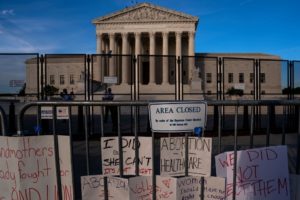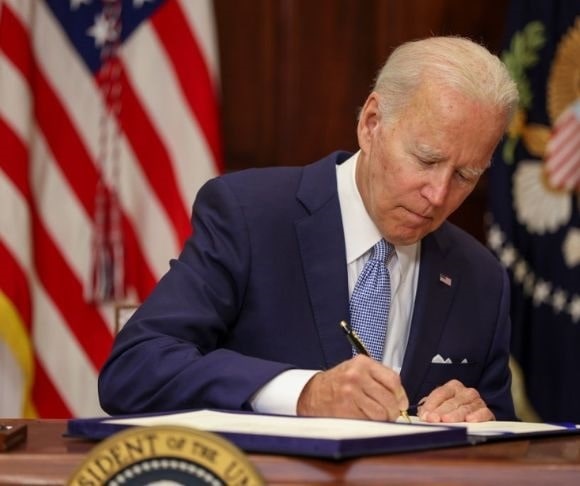The Dobbs v. Jackson Women’s Health Organization ruling showed “extreme ideology,” according to President Joe Biden. Yet he has done nothing. Democrats in both chambers of Congress and progressive professors nationwide implored the president to take “bold action” to fight back against the recent Supreme Court decision overturning Roe v. Wade. So, why does he hold back? Despite the apparent ignorance of dozens of Democrats inside the legislative process, even Joe Biden understands that abortion by executive order simply does not fall under his authority.
More than 30 Senate Democrats signed a letter to the president, demanding he “lead a national response to this devastating decision.” Progressive lawyers and college professors are racking their brains trying to find some handhold for executive power. Lawmakers from the Senate and House alike suggest executive overreaches that – if the president could manage them – would negate the purpose of having any branch of government but the executive.
Nuke the Filibuster
 One suggestion yet again making the rounds is for Biden to end the legislative filibuster. There are exactly two ways to change the rules of either the House of Representatives or the Senate: A vote in that chamber or an amendment to the Constitution, with the latter, of course, being considerably harder to achieve.
One suggestion yet again making the rounds is for Biden to end the legislative filibuster. There are exactly two ways to change the rules of either the House of Representatives or the Senate: A vote in that chamber or an amendment to the Constitution, with the latter, of course, being considerably harder to achieve.
To end the filibuster “in house,” the Senate would either have to vote on a rule change – and achieve the currently necessary 60-vote majority – or invoke what’s often called the nuclear option. To do so, someone would raise a point of order that the vote should be by simple majority. If the presiding officer of the Senate agrees, that ruling becomes the new precedent. The presiding officer could refuse, of course, but if a simple majority votes to overturn that ruling, then the filibuster is gone. This has been done before, of course – twice.
In 2017, Mitch McConnell (R-KY) was the majority leader, and he was mulling over nuking the filibuster for the confirmation of Supreme Court Justices to get then-President Donald Trump’s first nominee pushed through. He and the Republican majority did precisely that. Though the left lost its collective mind at the extreme move, it was a Democrat who set us on that path. As Liberty Nation’s Tim Donner wrote that April: “And McConnell has Harry Reid to thank for making his decision relatively easy. For when Reid, serving as Senate majority leader at the time, went nuclear on all federal judges except the Supreme Court in 2013, he opened the door through which McConnell can now walk.”
The Democrats went first, then the Republicans, and now it seems it may soon be the Democrats’ turn to finally finish the tit-for-tat whittling away of the rule – if Sens. Joe Manchin (D-WV) and Kyrsten Sinema (D-AZ) can be convinced, of course.
If the Democrats can’t get all 50 members of their caucus to end the filibuster, the president certainly can’t do it for them.
Limit the Court’s Power

(Photo by Nathan Howard/Getty Images)
Some suggested either limiting the power of the Supreme Court or increasing the number of Justices, then packing the court with progressives. Like the last topic, court packing is no new issue. And once again, this rests firmly in the hands of the legislature. Though the president nominates federal judges, including Supreme Court Justices, he must wait for a vacancy to come up before doing so. Expanding the court itself requires an act of Congress – and changing that requires an amendment to the Constitution.
There are a few other ways to manipulate the court, though few that fall under the president’s purview. Impeachment is always an option, but it requires majorities in both chambers of Congress. Though it has been tried on rare occasions, it has yet to succeed. New federal law can change the situations surrounding rulings, of course, but again that relies on the legislature.
The president – or a state’s governor – could choose to ignore a court ruling by refusing to act. For example, the Supreme Court ruled against medical marijuana in 2005, yet 11 states at the time continued to permit its use. The Obama administration later simply ignored the ruling as well and refused to enforce the previous administration’s stricter policies. This situation doesn’t lend itself to such a passive resistance, however. Ruling that marijuana wasn’t legal could be ignored by refusing to prosecute. Refusing to act in this case would simply allow the states that regulate abortion to continue to do so.
Federal Clinics

(Robert Gauthier/Los Angeles Times via Getty Images)
A final suggestion was that the administration could either build abortion clinics on federal land in restrictive states or even declare a state of emergency and have them built outside national parks. The first obvious problem with that is the Hyde Amendment, which bars the use of federal funds to pay for abortion except to save the life of the pregnant woman or if the pregnancy arises from rape or incest.
Regardless of bans or restrictions, of course, all 50 states will continue to allow abortion to save the pregnant woman’s life, rendering that a non-issue. Just 11 states explicitly restrict abortion beyond what Roe once allowed and don’t include an exception for rape – and only 12 lack an exception for incest. With rape accounting for an estimated 2%-3% of abortions, it seems the only allowed operations a federally funded abortion clinic could carry out that couldn’t already be done under state law would be few and far enough between as to make such clinics a tough expense to sell. Far less expensive would be to fund the travel to other states for women who qualify under this rule.
Any attempt to avoid the Hyde Amendment by leasing the land to private sector abortionists, of course, would negate the benefit of using this method to begin with – even if such a venture would be commercially viable. Individuals are still bound by state laws even when they enter federal property in the state, and the language of the various bills makes it clear that anyone who performs an illegal abortion would be guilty of a felony and subject to prosecution by the state.
The New Derangement?

Joe Biden (Photo by Tasos Katopodis/Getty Images)
Of course, these limitations are evident to those familiar with the Constitution and the checks and balances of our federal government. One might think 30-plus lawmakers would fall into that category; on some level, most of them likely do. That said, a large number of the bills that land in Congress are written not by the publicly elected official so much as by staffers or even outside corporations, lobbyists, or bill writing services – so, perhaps many of them don’t deserve much credit for understanding how government is supposed to work.
In any case, the panic to get Biden to act is largely just that – panic. Once the hard truth is accepted, that the president simply can’t change judicial or legislative practices at a whim, one is left just a few conclusions. The more charitable might assume these lawmakers are ignorant of their folly. Others might suggest, however, that they know the limitations and are just virtue signaling for the masses – or worse, that they aren’t.




